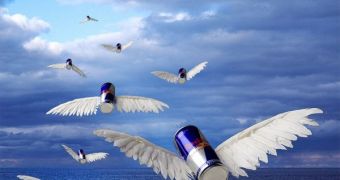If we were to believe the ad, then we'd most certainly have wings by now. You'll do more workout sessions than Schwarzenegger did when he was young and hold up for hours in the gym. Is it really like that? In the end, the effects are given by what the drink contains.
Glucose. Most energy drinks contain this essential carbohydrate. But this won't "give you wings." 200 ml of the drink can contain all of the sugar your body needs in a day.
Sugar induces a rapid momentary energy burst, as it is absorbed much faster than other energy source foods (such as fats or proteins) are. It raises the blood sugar level and gives you that quick energy supply. However, it lasts very little, as the body quickly releases insulin, which makes the glucose be rapidly absorbed in the tissues. And the sudden insulin burst plummets your blood sugar, and also your energy and endurance. These insulin fluctuations increase the appetite but, in the long run, they have been linked to type 2 diabetes.
Taurine ("taurus" means "bull" in Latin) was first found in the bull's bile in 1827. Even our body produces small amounts of taurine. Now produced synthetically, it is regarded as a magic potion that turns any geek into a performer.
Taurine increases the amount of potassium, sodium, calcium and magnesium into and out of the cells, these ions being involved in nerve signals, acting as an inhibitory neurotransmitter (and mild sedative) and antioxidant. But most researches have shown that taurine does not give more energy, even if it might help in decreasing muscle fatigue and it potentially steadies irregular heartbeats.
Glucuronolactone is produced by the liver and it is also found in many plant gums. It is believed to fight against fatigue, being a stimulant and boosting memory and concentration. It increases the serotonin ("well-being") hormone levels. But it won't grow wings.
Caffeine seems to be Red Bull's most active component. This alkaloid found in coffee and guarana and even in tea and chocolate, works by stimulating your brain, the same as amphetamines, cocaine, and heroin do. A 300 ml of caffeinated energy drink contains the caffeine quantity from an 150 ml cup of coffee.
Inside the brain, caffeine blocks the chemical that makes you naturally drowsy, increasing concentration and reaction speed. The chemical, adenosine, is also involved in dilating the blood vessels. This way, caffeine makes the brain's blood vessels constrict.
The heart beats rate increases, muscles tighten, the blood pressure booms, blood vessels near the surface constrict and more blood flows to the muscles. Caffeine also increases dopamine, the "happy feeling" hormone, in your brain and it is a mild diuretic.
But if you're going to make bodybuilding training, the heart beats can increase up to a dangerously high level, while triggering extremities shivering and nausea.
Moreover, the long term effects can be really tricky. Once the temporary stimulation stops, the brain cells begin to need caffeine for stimulation and a sudden neural sluggishness installs. The unnatural heart racing is unhealthy, and can trigger heart problems. Sleep is damaged and the alkaloid needs 12 hours to be completely eliminated from your body.
Due to the diuretic effects, the caffeine - while speeding the urination cycle - "steals" calcium which is lost through urine. Long term, heavy caffeine use leads to a rapid development of osteoporosis.
Niacin (niacinamide, vitamin B3) increases the "good cholesterol" (HDL) impeding the synthesis of triglycerides. But you have to drink a lot of Red Bull to see these effects. Niacin also removes toxins from the body, and it is involved in the synthesis of steroid hormones, like sex hormones and stress-related ones.
Sodium citrate causes the sour taste of the drink. It helps the anaerobic burning of glucose into lactic acid during physical exercise and was proven to increase sport performances.
Inositol is a chemical that our body produces and which is found in many foods, like cereals, nuts, beans, and fruit, especially cantaloupe melons and oranges. Inositol has been proven to fight depression, panic attacks, agoraphobia, and obsessive-compulsive disorder. Still, the amounts of Inositol in Red Bull are too small to be effective in this case (about 360 cans of it would induce a visible effect).

 14 DAY TRIAL //
14 DAY TRIAL //